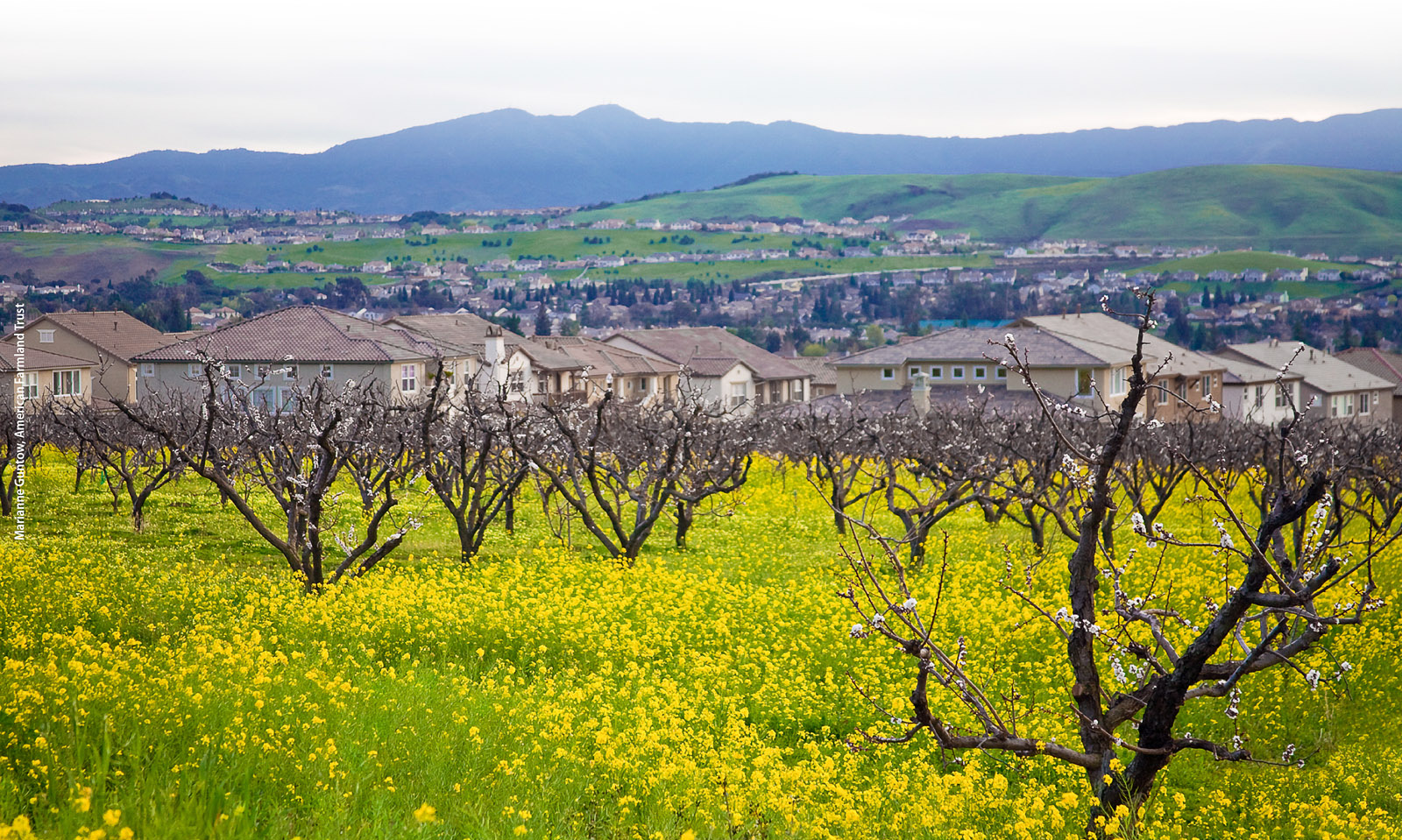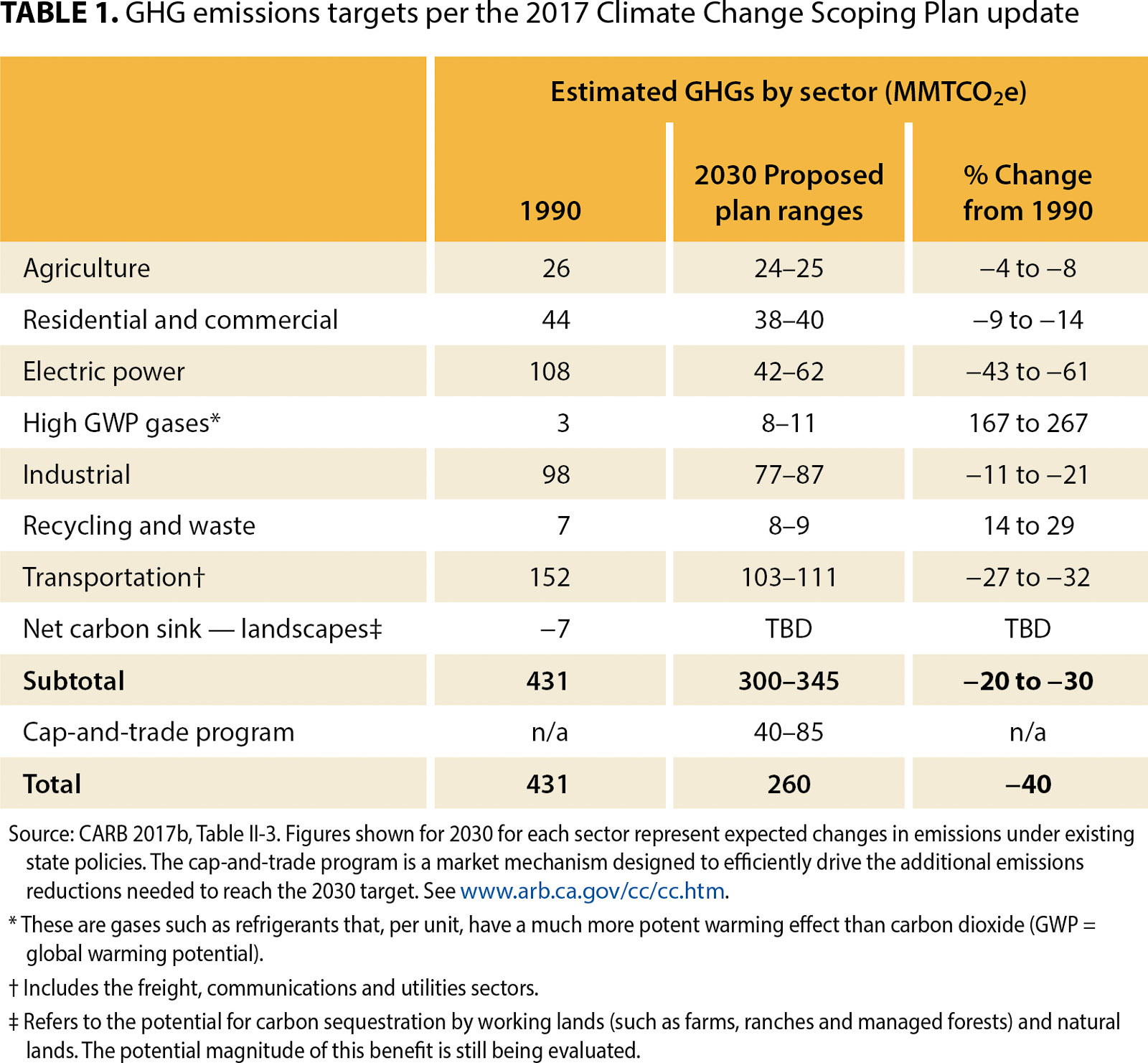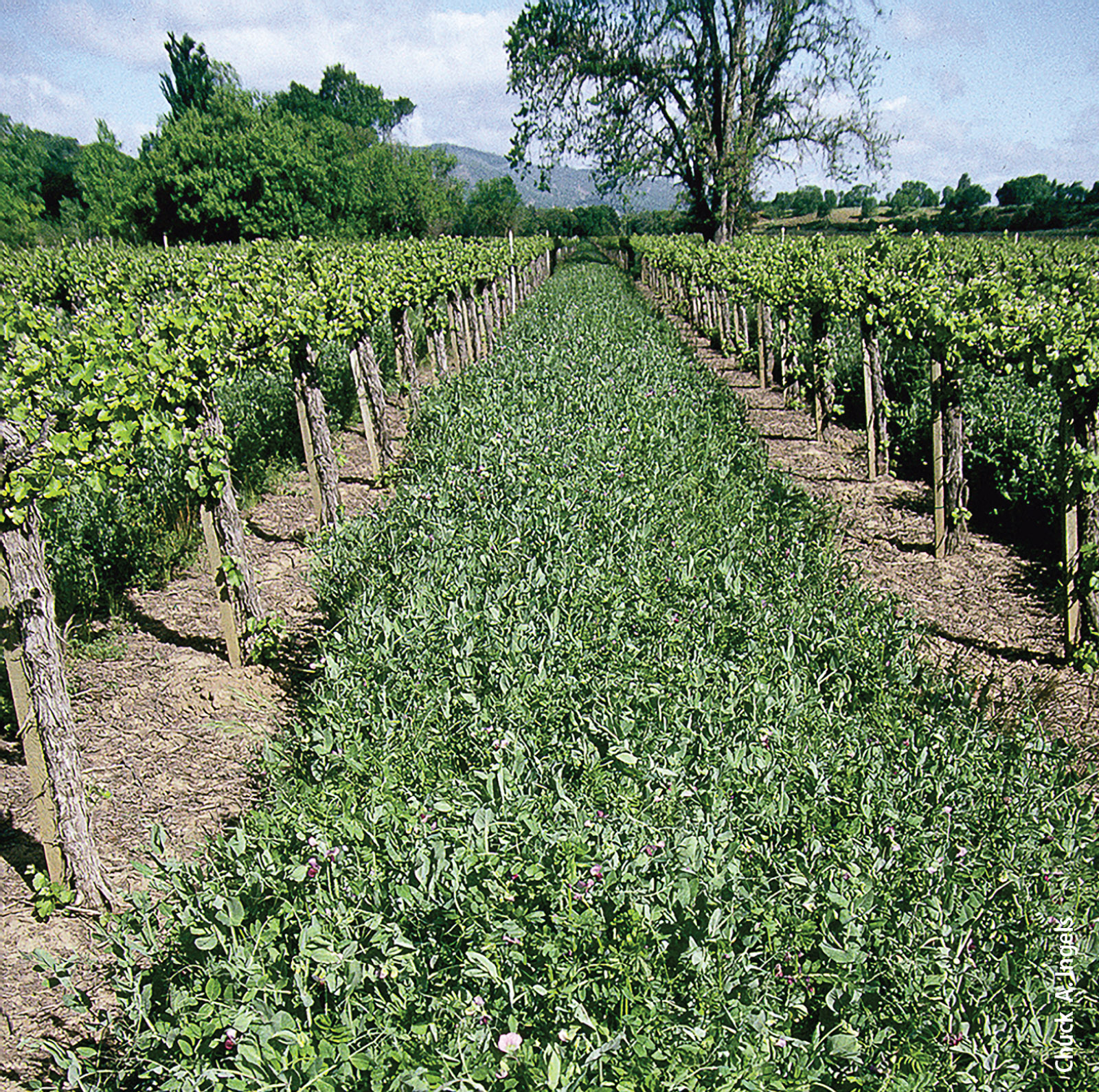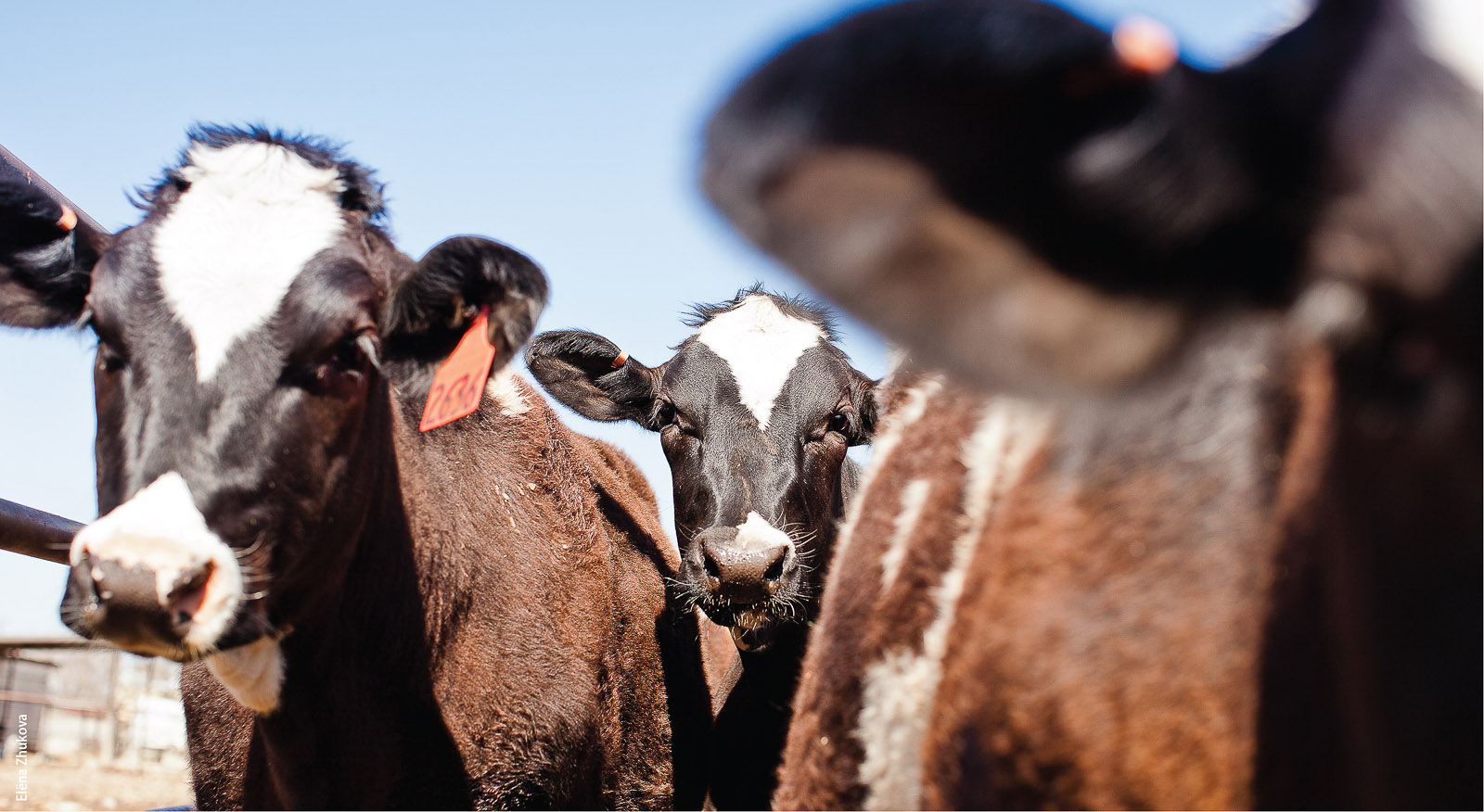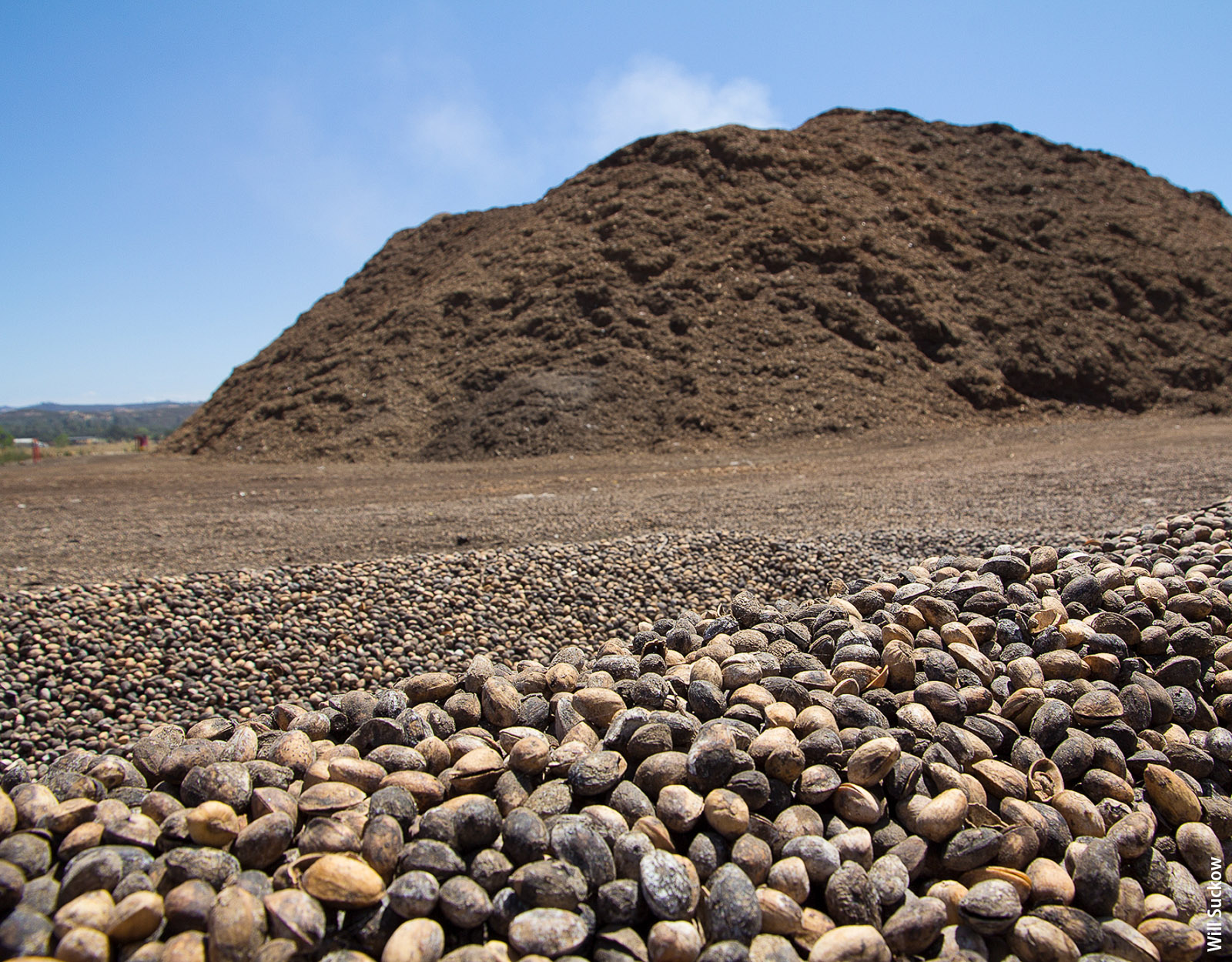All Issues
Review of research to inform California's climate scoping plan: Agriculture and working lands
Publication Information
California Agriculture 71(3):160-168. https://doi.org/10.3733/ca.2017a0031
Published online September 13, 2017
PDF | Citation | Permissions
NALT Keywords
Abstract
Agriculture in California contributes 8% of the state's greenhouse gas (GHG) emissions. To inform the state's policy and program strategy to meet climate targets, we review recent research on practices that can reduce emissions, sequester carbon and provide other co-benefits to producers and the environment across agriculture and rangeland systems. Importantly, the research reviewed here was conducted in California and addresses practices in our specific agricultural, socioeconomic and biophysical environment. Farmland conversion and the dairy and intensive livestock sector are the largest contributors to GHG emissions and offer the greatest opportunities for avoided emissions. We also identify a range of other opportunities including soil and nutrient management, integrated and diversified farming systems, rangeland management, and biomass-based energy generation. Additional research to replicate and quantify the emissions reduction or carbon sequestration potential of these practices will strengthen the evidence base for California climate policy.
Full text
California has committed to cutting greenhouse gas (GHG) emissions by 40% of 1990 levels by 2030. As a sector, agriculture is responsible for 8% of state emissions. Approximately two-thirds of that is from livestock production (manure management and enteric fermentation); 20% from fertilizer use and soil management associated with crop production; and 13% from fuel use associated with agricultural activities (e.g., irrigation pumping, cooling or heating commodities) (CARB 2017a). California plays an essential role in the nutritional quality of our national food system, accounting for, by value, roughly two-thirds of U.S. fruit and nut production, half of U.S. vegetable production and 20% of U.S. dairy production.
Converting farmland and rangeland to residential and urban uses results in a net increase of greenhouse gas emissions. Reducing the rate of conversion helps to avoid such emissions.
Assembly Bill 32, California's primary climate policy law, adopted in 2006, has spurred research into practices and technologies that could assist in reducing emissions and sequestering carbon. Here we report on more than 50 California-based studies prompted by this landmark legislation. We note that the California Department of Food and Agriculture, California Air Resources Board, California Energy Commission and California Department of Water Resources have been critical to funding much of the science reviewed here. This article grew out of conversations with state agencies concerning the need for a review of the current evidence base to inform emissions-reduction modeling and revisions to the state Climate Change Scoping Plan (CARB 2017b), which specifies net emissions reduction targets for each major sector of the California economy (table 1). It is important to note that the Scoping Plan states that work will continue through 2017 to estimate the range of potential sequestration benefits from natural and working lands (including agriculture and rangelands).
With over 76,000 farm and ranch operations in California, covering about 30 million acres (USDA 2015), there are no one size fits all solutions. But as we outline below, there are numerous opportunities to both reduce GHG emissions and sequester carbon across diverse agricultural operations — small to large, organic and conventional, crop and livestock. Perhaps most importantly, many of these practices have co-benefits for water conservation, restoration and conservation of natural lands, or farm economics.
Farmland and rangeland preservation
Since 1984, farming and grazing lands have been converted to urban development at an average rate of 40,000 acres per year (DOC 2016). At this rate, and considering the higher rate of emissions from urban versus agricultural land, slowing agricultural land conversion represents one of the largest opportunities for agriculture to contribute to California's climate plan. Research from one county estimates that GHG emissions associated with urban landscapes are up to 70 times greater per acre than those from irrigated farmland when human emissions related to transportation, electricity, natural gas, and water are accounted for (Haden et al. 2013; Jackson et al. 2012). With continued population growth in the state, policies that promote more energy efficient patterns of urban development are critical to meeting climate targets and preserving irreplaceable farmland. Models show that coupling such urban development policies with farmland conservation could reduce transportation and building-related emissions from new residential development by 50% by 2050 under a low-emissions scenario (Wheeler et al. 2013).
With 80% of California's most productive rangeland privately owned, losses are projected at 750,000 acres by 2040 (Cameron et al. 2014). Conversion of rangeland to urban uses may increase GHG emissions up to 100-fold depending on how the rangeland is managed, and conversion to irrigated agriculture may lead to increases of up to 2.5-fold (Haden et al. 2013).
Land-use-related policies to reduce GHG emissions in California are still at an early stage. Several new incentive programs warrant future research to optimize their impact. These include the Sustainable Agricultural Lands Conservation Program (SALC), for purchase of conservation easements on farmland at risk of suburban sprawl development; the Affordable Housing and Sustainable Communities Program (AHSC), supporting development of affordable housing within existing urban areas; and the Transformative Climate Communities Program (TCC), slated to provide GHG-reducing planning grants to disadvantaged communities beginning in 2017. Together with legislation requiring a regional Sustainable Community Strategy, these can create a land use planning framework in California to preserve farmland, reduce GHG emissions, and achieve other co-benefits such as improved quality of life, public health and social equity.
Soil and nutrient management
Soils are complex biological systems that provide ecosystem services and can be managed to store carbon, reduce emissions and provide environmental and economic co-benefits. The diversity of California agriculture requires different management strategies to mitigate GHG emissions or sequester carbon.
Soil GHG emissions increase with soil moisture and nutrient availability. Significant reductions in GHG emissions can be achieved by shifting management practices to more efficient irrigation and fertigation systems such as micro-irrigation and subsurface drip. A comparison of subsurface drip versus furrow irrigation showed decreased GHG emissions in the former (Kallenbach et al. 2010; Kennedy et al. 2013). While cover crops often increase GHG emissions, integrating more efficient irrigation with cover crop practices decreased nitrous oxide emissions two- to three-fold in California processing tomatoes (Kallenbach et al. 2010; Kennedy et al. 2013).
In semi-arid regions such as California, the long-term implementation of no-till practices reduced emissions by 14% to 34%, but only after 10 years of continuous management. Under shorter time horizons, emissions increased by up to 38% (Six et al. 2004; van Kessel et al. 2013). Socioeconomic and biophysical limitations unique to California have led to low no-till adoption rates in California of roughly 2% (Mitchell et al. 2009).
Improved nitrogen management provides a high potential for reductions in emissions, including emissions associated with applied fertilizer as well as emissions related to the production and transport of inorganic nitrogen fertilizer (Steenwerth et al. 2015). N2O emissions respond linearly to fertilizer application in lettuce, tomato, wine grape and wheat systems in California (Burger et al. 2012). However, once fertilizer rate exceeds crop demand, emissions increase at a logarithmic rate (McSwiney et al. 2005).
Fertilizer source has been broadly shown to influence N2O emissions (Burger et al. 2011). Only a few California studies compare synthetic fertilizer sources. One shows that ammonium sulfate reduced N2O emissions approximately 0.24 to 2.2 kg N per acre compared to aqua ammonium (Zhu-Barker et al. 2015a). Another study of comparing fertilizer sources found emissions reductions of up to 34% (Brown and Muhammad 2011; Schellenberg et al. 2012); however, the results were not statistically significant. Recently, California research has shown that the use of manure and green waste fertilizers can increase emissions when applied to the soil surface (Zhu-Barker et al. 2015b), particularly if their use is not timed to crop demand (Lazcano et al. 2016). Fertilizer source and timing, along with the use of nitrification inhibitors, are key areas for future research in the California context.
A no-till field with residue from a winter crop of triticale. Management practices can increase total soil carbon, but the magnitude and persistence of sequestration is dependent on inputs and time.
Management practices have the potential to increase total soil carbon, but the magnitude and persistence of sequestration is dependent on inputs and time. In grasslands, pilot studies of carbon sequestration associated with compost application are being conducted to validate early findings throughout the state (see “Rangeland management” section below). For cultivated systems, in two long-term projects at UC Davis, soil carbon increased 1.4 and 2.3 tons per acre in the top 12 inches of soil over 10 years (0.14 and 0.23 tons per acre per year) in cover cropped and organically managed soil, respectively (Poudel et al. 2002). In an ongoing experiment at the UC Agriculture and Natural Resources West Side Research and Extension Center, no-till combined with cover cropping and standard agronomic practice in a tomato-cotton rotation system has increased soil carbon 5.3 tons per acre over 15 years (0.3 tons per acre per year) compared to the standard tillage, no cover crop treatment (Mitchell et al. 2017).
In these two long-term studies, the soil carbon increase occurred between 5 and 10 years. However, when cover cropping and compost inputs were ceased at the first site (Poudel et al. 2002), it led to a rapid loss of soil carbon. This shows that soil carbon sequestration is highly dependent on annual carbon inputs and if management changes, soil carbon is prone to return to the atmosphere.
Given the reality of inconsistent management, rates of soil carbon sequestration that can be expected in row crop systems practice are perhaps 10% of the values seen in these long-term research trials, namely in the range of 0.014 to 0.03 tons per acre per year (unpublished data). If soil carbon sequestration and storage are priorities, management plans and incentive structures should account for the wide variability of California soils and the need for consistent management over time.
While any single soil and nutrient management practice may have limited impact on GHG emissions, many have well-documented co-benefits, including reductions in erosion, improved air quality (Madden et al. 2008), reduced farm machinery fossil fuel use (West et al. 2002), reduced nitrogen leaching (Poudel et al. 2002), enhanced water infiltration and reduced soil water evaporation (Mitchell 2012), and increased carbon stocks below the root zone to improve carbon sequestration (Suddick et al. 2013).
Integrated and diversified farming systems
Integrated or diversified farming systems are multipurpose operations that may produce several commodities and utilize renewable resources. Examples include integrated crop and livestock systems; organic production; orchard and annual crop intercropping; use of perennial, salt-tolerant grasses irrigated with saline drainage water on otherwise marginal land; and pastures improved by seeding beneficial plants such as legumes. Through reliance on biological processes to build healthy soils and support above and below ground biodiversity, diversified systems offer potential GHG emission reductions (through, for instance, application of on-farm sources of organic matter residues from plants and animals rather than fossil fuel–based fertilizers, carbon storage in woody plants, and more efficiency in nutrient management due to crop rotations). Also, resilience to climate perturbations can occur by spreading economic risks across multiple farm products (Jackson et al. 2011) and by relying on on-farm resources and biodiversity, with less dependence on synthetic fertilizer and pesticides to improve soil and crop health (Gurr et al. 2003; Hodson and Lewis 2016; Suddick et al. 2010). Other environmental co-benefits can include more efficient use of water, improved water and soil quality, pest reduction or suppression, or enhancement of wildlife habitat and biodiversity.
These systems have been shown to reduce soil nitrate and nitrous oxide emissions, and increase carbon sequestration both in soils and above ground biomass (Bowles et al. 2015; Garland et al. 2011; Smukler et al. 2010, 2011; Williams et al. 2011). For example, frequent addition of various types of organic inputs increases labile and resistant soil carbon over a period of several years, so that soils exhibit more tightly coupled plant-soil nitrogen cycling. In turn, plant nitrogen demand is adequately met, but losses of nitrate are minimized (Bowles et al. 2015). In another case, an organic vegetable production system, the annual use of cover crops over 6 years led to greater increases in microbial biomass carbon pools, and compost additions increased measured soil organic carbon pool and microbial diversity in comparison to a cover crop grown every fourth year (Brennan and Acosta-Martinez 2017). Many of these studies examined California organic farms where multiple practices are often stacked, such as combining organic soil amendments, integrating cover crops into crop rotation for year-round plant cover and reducing tillage. In addition, farmscaping with perennials on field margins and maintenance of vegetated riparian corridors sequester carbon in the soil and woody biomass of trees and shrubs (Hodson et al. 2014; Smukler et al. 2010). Planting native woody species tolerant of drought for hedgerows, or resistant to water flux in riparian corridors, is a way to ensure adaptation and growth over many decades. Use of tailwater ponds and sediment traps also plays an important role in soil and water quality (Smukler et al. 2011).
Diversified, multipurpose systems provide other co-benefits depending on the set of practices involved. Practices that increase soil carbon also improve soil structure, nitrogen-supplying power and water-holding capacity (Burger et al. 2005). For example, a practice like cover cropping also can suppress weeds, influence crop nutrition and quality, especially in perennial systems like wine grapes, and provide habitat for beneficial predators (Guerra and Steenwerth 2011). Filter strips and riparian corridors can reduce soil erosion and thereby diminish contamination of surface water with valuable soil and nutrient resources, and pathogenic microbes (Tate et al. 2006). Hedgerows have been shown to increase pollinators and other beneficial insects in California (Morandin et al. 2011; Ponisio et al. 2015). Given the promise for multiple co-benefits, more types of California diversified systems deserve study, which would provide a better basis for metrics to evaluate their long-term contributions to climate and other goals.
Dairy and intensive livestock
Intensive livestock operations, particularly the state's large dairy sector, produce two-thirds of California's agricultural GHG emissions, and thus are a primary target for state climate regulations as well as incentives for emission reduction. At the same time, policies should account for the already high levels of resource efficiency in the California dairy sector. A key climate policy concept is to avoid “leakage,” whereby strict climate policy to reduce emissions in one region causes increases in another. A recent comparison of the dairy sectors of the Netherlands, California and New Zealand documents that California dairies on average produce more milk per cow than dairies in the Netherlands, and more than 2.6 times as much as dairies in New Zealand, while operating under stricter environmental regulations (Rabobank 2014).
Currently, the Intergovernmental Panel on Climate Change (IPCC) recommends using a fixed emission factor for dairy operations that is based on gross energy intake, which does not take diet composition into consideration (IPCC 2006). Calibration of GHG models for California using dietary information will provide a more accurate basis for measuring progress than current IPCC values, and for assessing the potential benefits of different forage and feed practices on emissions. There are several methodologies developed in the last few years that can provide more accurate estimates of GHG emissions in California (Moraes et al. 2014; Santiago-Juarez et al. 2016). These methods incorporate the impact of diet, accounting for, as an example, the fact that fiber content is positively associated with methane emissions while lipid content is negatively correlated.
The dairy and beef cattle sectors together account for almost two-thirds of the state's agricultural GHG emissions. Changes to feed and manure management practices can reduce these emissions.
About half of California's livestock GHG emissions comes from enteric fermentation and half from manure in concentrated beef cattle and dairy operations. The largest opportunities for changes in livestock practices center on feed (composition and precision feeding) and manure management. California offers a uniquely diverse range of crop byproducts for use as dairy cow feeds, and research has improved our understanding of the impacts of different feeds on productivity, economics and GHG emissions (Moate et al. 2014; Moraes et al. 2015; Niu et al. 2016). For example, grape pomace, a byproduct of the wine industry, has been shown to reduce methane emissions when fed to dairy cattle in pelleted form without reducing milk production (Moate et al. 2014). A shift towards solid manure management practices (such as solid scrape) may result in reduced GHG emissions by reducing the anaerobic digestion that occurs when water is used to flush manure into storage lagoons. However, Owen and Silver (2017) indicated solid manure management can produce substantial GHG emissions; thus, minimizing manure storage time is important to mitigating emissions. One caution: there is a risk that focusing on one climate pollutant, such as methane, could lead to practices that have negative trade-offs, such as increased N2O emissions (Owen and Silver 2017), and nutrient loading in soil and water (Niu et al. 2016).
A recent report submitted to the California Air Resources Board suggests it may be technically feasible for California to achieve a 50% reduction in methane emissions from dairy manure management by 2030 if supportive policies are created (Kaffka et al. 2016). This would require capturing or avoiding methane generated from manure storage on dairies from an estimated 60% of dairy cows in California, particularly the largest dairy operations where cost-benefit considerations are most favorable (CARB 2016). If successful, a gallon of California milk may be the least GHG intensive in the world. The report outlines several alternative manure management practices and technologies. These include:
-
Switching from flush water lagoon systems without methane capture to solid-scrape or dry manure management;
-
Covering manure lagoons to capture biogas, which can then be used for transportation fuels, on-farm electricity, or injected into natural gas pipelines;
-
Installing anaerobic digesters to capture and utilize methane for similar uses, supported by CDFA's dairy digester program;
-
Pasture-based dairy management, in which manure is left on the field and decomposes largely aerobically (producing significantly less methane than in anaerobic decomposition), though N in manure may be used less efficiently as a fertilizer in this case.
A diversity of practices is needed to reflect the range of dairy sizes and layouts in California. For example, lagoon storage systems, which can emit large amounts of methane, lend themselves to the use of covers or engineered anaerobic digestion systems for bio-methane collection. Potential trade-offs of these practices with respect to air quality, crop management, nutrient use efficiency and cost, however, require further analysis. Pasture systems are used in coastal areas where farms have less crop land available than in the Central Valley; pasture requires significantly more land and water for feed production compared to current dairy systems that rely on corn silage, grass silage and alfalfa (CARB 2016).
Rangeland management
Comprising more than two-thirds of California's agricultural acreage (USDA 2015), these working lands provide ecosystem services in addition to supporting production of livestock. Grasslands have higher levels of total soil carbon compared to cultivated lands (Steenwerth et al. 2005), and similar amounts to California forests.
There are numerous options for increasing carbon storage in rangelands. Modeling analyses project that restoration of native oaks could increase carbon storage in wood biomass and litter (Kroeger et al. 2009). In a study of riparian revegetation in Marin, Sonoma and Napa counties, modeled soil carbon sequestration rates averaged 0.8 tons C per acre per year, while modeled results of restored woody riparian areas demonstrated ecosystem carbon storage potential (soil plus woody biomass) of 16.4 tons C per acre per year over a 45-year period (Lewis et al. 2015). Cultivation and re-seeding to restore native perennial grasses also shows promise. Native grasses may sequester carbon in slightly deeper soil levels due to perennial root systems (Potthoff et al. 2009; Steenwerth et al. 2002). Rangelands with native grasses and oaks have lower soil carbon losses (Koteen et al. 2011) and higher nitrogen cycling rates (Parker et al. 2009).
Approaches to verifying carbon sequestration on rangelands requires a long-term approach. Soil carbon can take decades to build to a measurable level: rangelands rarely receive intensive management and these systems are much more exposed than irrigated agriculture to annual variations in moisture. On average, California's grasslands lose carbon, but the net C gain or loss depends on precipitation, with net losses of carbon in years when the timing of precipitation causes a short growing season, and gains when the timing of rains lead to a longer growing season (Ma et al. 2007).
Restoration of native oaks and woody riparian areas on rangelands offers opportunities for increasing carbon storage in these systems.
The use of composted materials in rangelands may reduce N2O emissions in comparison to those materials entering waste streams and being subject to the standard manure and green waste management practices (Ryals et al. 2013; DeLonge et al. 2013). One study on California's coastal and valley grasslands showed that use of compost above standard application rates could boost net ecosystem carbon by 25% to 70%, sequestering carbon at a rate of 0.2063 tons C to 0.2104 tons C per acre over the 3-year study or a rate of 0.0688 tons C to 0.0701 tons C per acre per year, largely by decreasing the amount of C that is being lost from these grasslands (Ryals et al. 2013). Researchers using the DAYCENT model to look at different compost amendments and project over longer time frames found that the net climate mitigation potential ranges from 0.5261 to 0.6394 tons CO2 equivalent per acre per year in the first 10 years (Ryals et al. 2015), and declines by approximately half of that by year 30. Applying organic materials to rangelands in Southern California demonstrated co-benefits: stabilizing soil nitrogen stocks, improved plant community resilience and productivity, and increased soil organic matter after 1 year of application (Zink and Allen 1998). However, due to the very limited number of studies and the need to demonstrate sustained carbon sequestration, long-term studies (greater than 10 years) that span California rangelands are needed to validate these results and provide long-term policy recommendations. Climatic variation across the state may enhance or diminish observable carbon sequestration benefits. Further, it will be important to ensure that rangeland compost application practices do not lead to undesired plant species shifts and do not create negative trade-offs for water quality through nutrient run-off or leaching; it will also be important to track emissions associated with fossil fuel use for transportation and distribution of compost across rangeland sites.
Additional practices that have shown benefit elsewhere and should be examined in California include planting of legumes, fertilization, irrigation and grazing management. In particular, grazing management may significantly impact rangeland carbon sequestration. While heavy grazing that leads to erosion can degrade carbon storage, there is conflicting evidence in California and elsewhere on specific grazing practices that can benefit soil carbon (DeLonge et al. 2014). Most studies in California that have assessed the effects of grazing on soil carbon compared only grazed versus ungrazed (e.g., Silver et al. 2010), without assessing the effects of grazing duration, intensity, frequency and rest periods.
The USDA Natural Resources Conservation Service provides cost-share programs for range managers to split the cost of implementing improved management techniques. Currently, only 30% to 40% of California ranchers participate in these programs (Lubell et al. 2013). The research above points to the magnitude of opportunity from alternative rangeland practices and the need to identify socioeconomic opportunities and barriers to greater participation in range management incentive programs.
Biomass-based energy production
The most recent assessment of biomass in California details the availability of resources, including agricultural biomass, among others, that could support generation of three to four times the current biomass-based renewable energy being produced, depending on policies and regulations affecting biomass use (California Biomass Collaborative 2015). Biomass use for energy, however, has declined in recent years, as it is generally more expensive than alternative fuels. In addition, interconnection issues between biomass facilities, such as anaerobic digesters, and utilities complicate and increase the cost of new facilities. Research and policy actions to reduce barriers and incentivize co-benefits from the use of biomass for power and fuel will be required to expand this sector sustainably.
Current biomass energy production from agricultural residues in California is largely based on combustion of nut shells and woody biomass from orchards and vineyards. While one grower has installed a successful on-farm small-scale gasification systems for nut shells and wood chips, larger scale facilities that convert woody biomass to electricity are typically more than 40 years old, and the power produced is more expensive than other forms of alternative energy. Many plants are now idle or closed, leaving tree and vine producers with few or more expensive options for disposal of biomass.
Currently, biomass energy production in California from agricultural residues — such as pistachio shells (foreground) and wood chips (background) — is largely based on the combustion of material from orchards and vineyards. Because biomass-based energy is more expensive than other renewable sources, policy changes or incentives are needed to expand this sector.
Other underutilized agricultural biomass includes rice straw and livestock manures suitable for anaerobic digestion technology (Kaffka et al. 2012 and 2016). Manure alone is not a high biogas-yielding feedstock. Supplementing manure with fermentable feedstocks such as crop or food processing residues (Amon et al. 2011) can improve the energy and economic return from anaerobic digesters (Kaffka et al. 2016), but this practice currently faces regulatory and practical obstacles, like managing an additional source of organic materials and additional nutrients and salts. Nonetheless, there is limited, but real potential for some crop-based biofuels and bioenergy in California based on locally optimal feedstocks and biorefineries (Jenkins et al. 2009; Kaffka et al. 2014).
Priorities for future research
Here we identify cross-cutting priorities that will enable scaling and, equally important, the integration of multiple practices to achieve more substantial progress toward both climate change mitigation and adaption in agriculture. Among the priorities we identify are:
-
Replication and longer-term studies to quantify the GHG mitigation or carbon sequestration associated with specific practices.
-
Quantification of synergies from stacking multiple practices over time and scale (e.g., field to region) to address efficacies for carbon sequestration, emissions reductions and nitrogen use.
-
Characterization and, where possible, quantification of co-benefits (water, economic, air quality) from soil management practices, livestock grazing and manure management, and biomass-based fuels.
-
Using social and political science research to identify socioeconomic factors that either create barriers or promote adoption of practices (e.g., social networks, gender, social norms, and values).
-
Validation of metrics for soil health parameters, including calibration of models for California conditions that may be used to estimate metrics, such as:
-
Potential use of remote sensing to measure adoption of specific practices outlined above.
-
Validation and/or calibration of models for estimating GHG emissions, including the crop and soil process model, DAYCENT (Del Grosso et al. 2005), and the USDA's whole farm and ranch carbon and GHG accounting system, which uses the DAYCENT model (COMET-Farm; http://cometfarm.nrel.colostate.edu/ ).
-
Research into the design of incentives (such as payments, tax credits, low interest loans, etc.) to leverage private investment and promote adoption of emissions-reduction practices in agriculture.
-
Development of metrics and sampling or survey tools to assess adoption of emissions-reduction practices.
-
Development of farmer demonstration and evaluation networks for scaling up the adoption of improved performance systems.
As this report outlines, the practices and technologies that can assist California to meet its climate change goals are as diverse as the types of agricultural practices across the state. Support for research within California agro-climactic contexts has been critical to identifying these climate strategies. Similarly, state incentive programs are critical to promoting adoption of these practices at scale through co-investment with the agriculture sector to achieve the goal of sustaining a vibrant food system for our state and nationally.



